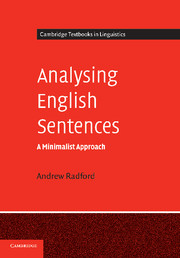1 - Grammar
Summary
Overview
In broad terms, this book is concerned with aspects of grammar. Grammar is traditionally subdivided into two different but interrelated areas of study – morphology and syntax. Morphology is the study of how words are formed out of smaller units (called morphemes), and so addresses questions such as ‘What are the component morphemes of a word like antidisestablishmentarianism, and what is the nature of the morphological operations by which they are combined together to form the overall word?’ Syntax is the study of the way in which phrases and sentences are structured out of words, and so addresses questions like ‘What is the structure of a sentence like What's the president doing? and what is the nature of the grammatical operations by which its component words are combined together to form the overall sentence structure?’ In this chapter, we begin (in §1.2) by taking a brief look at the approach to the study of syntax taken in traditional grammar: this also provides an opportunity to introduce some useful grammatical terminology. In the remainder of the chapter, we look at the approach to syntax adopted within the theory of Universal Grammar developed by Chomsky.
Traditional grammar: categories and functions
Within traditional grammar, the syntax of a language is described in terms of a taxonomy (i.e. classificatory list) of the range of different types of syntactic structures found in the language.
- Type
- Chapter
- Information
- Analysing English SentencesA Minimalist Approach, pp. 1 - 38Publisher: Cambridge University PressPrint publication year: 2009

